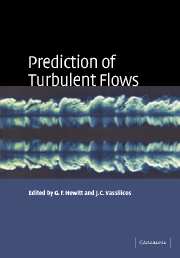Book contents
- Frontmatter
- Contents
- 1 Introduction
- 2 Developments in the understanding and modelling of turbulence
- 3 RANS modelling of turbulent flows affected by buoyancy or stratification
- 4 Turbulent flames
- 5 Boundary layers under strong distortion: an experimentalist's view
- 6 Turbulence simulation
- 7 Computational modelling of multi-phase flows
- 8 Guidelines and criteria for the use of turbulence models in complex flows
6 - Turbulence simulation
Published online by Cambridge University Press: 12 August 2009
- Frontmatter
- Contents
- 1 Introduction
- 2 Developments in the understanding and modelling of turbulence
- 3 RANS modelling of turbulent flows affected by buoyancy or stratification
- 4 Turbulent flames
- 5 Boundary layers under strong distortion: an experimentalist's view
- 6 Turbulence simulation
- 7 Computational modelling of multi-phase flows
- 8 Guidelines and criteria for the use of turbulence models in complex flows
Summary
Introduction
Computer simulation of turbulent flows is becoming increasingly attractive due to the greater physical realism relative to conventional modelling, at a cost that is reducing with continuing advances in computer hardware and algorithms. The first turbulence simulations appeared over 30 years ago, since when we have seen increases in computer performance of over four orders of magnitude such that many of the canonical turbulent flows first studied by laboratory experiments can now be reliably simulated by computer. Examples include turbulent channels (Kim et al., 1987), turbulent boundary layers (Spalart, 1988), mixing layers (Rogers & Moser, 1994), subsonic and supersonic jets (Freund, 2001, Freund et al., 2000) and backward-facing steps (Le et al., 1997). Where simulations can be reliably made, they provide more data than are available from laboratory experiments, even with modern non-intrusive flow diagnostics. In these situations they provide insight into the basic fluid mechanics. This can be at a very simple flow visualisation level, where a conceptual picture of what is happening in a flow can be quickly obtained from computer animations of key features, or at more advanced levels where the simulations provide statistical data to assist Reynolds-averaged model development. Indeed, several important recent turbulence models have come out of groups who do both simulations and modelling, examples being the Spalart & Allmaras (1994) model and Durbin's K-ε-ν2 (Durbin, 1995), and it is rare to come across a turbulence modelling paper that has not used simulation data as a reference.
- Type
- Chapter
- Information
- Prediction of Turbulent Flows , pp. 207 - 235Publisher: Cambridge University PressPrint publication year: 2005
- 2
- Cited by

